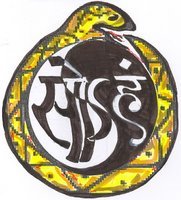Swami Veda Lectures
For the first time since I have been here, Swami Veda gave a public lecture in both English and Hindi. I had heard him speak before on Christmas, when he wrote a poem he had written and said a few words of introduction to the program. However, today after meditation, he invited everyone to stay and spoke on the subject of atmavabodha . Swamiji has an interesting style. He speaks slowly and deliberately, almost hypnotically, and repeats his speech almost word for word in Hindi afterwards. He has clearly prepared his thoughts in advance and rarely has to correct or add anything further in either English or Hindi. He also includes a guided meditation in the course of speaking. I noticed from his book, The Philosophy of Hatha Yoga , which seems to be based on a series of public lectures, that he did the same there. The overall effect is very powerful in a group of committed disciples--everyone is very attentive and goes deep into meditation when given the appropriate suggestions. In fact,




